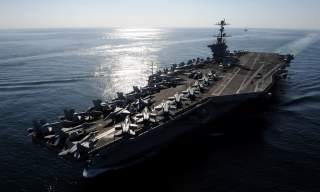Here's A Crazy Idea: A European Union Aircraft Carrier
Why? We explain.
Maybe Germany is planning revenge for Brexit by sinking British merchant ships in the North Atlantic again.
Because otherwise, a top German politician’s call for a European Union aircraft carrier doesn’t make much sense.
Annegret Kramp-Karrenbauer, president of Germany’s Christian Democratic Union and a likely successor to Chancellor Angela Merkel, created a stir when she advocated that European nations work together to build a carrier.
“Germany and France are already working together on the project of a European future combat aircraft,” she wrote in an essay in the German newspaper Die Welt (English translation here). “The next step could be the start of the symbolic project of building a common European aircraft carrier to express the global role of the European Union as a power ensuring security and peace.”
Merkel seemed to endorse the idea. "It's right and good that we have such equipment on the European side, and I'm happy to work on it."
Ironically, Kramp-Karrenbauer was actually rejecting a call by French President Emmanuel Macron for tighter European integration. “There is no version of a European superstate which can live up to the goal of a Europe made up of sovereign member states, and able to take action,” she wrote.
But that still leaves room for a common European defense policy, including a European Security Council that includes Britain. And, a European aircraft carrier.
Significantly, even Kramp-Karrenbauer referred to the Euro-carrier as a “symbolic act.” The value of an aircraft carrier is that it is a mobile airfield that can station aircraft near places that might be difficult to reach with land-based aircraft. That’s important to some nations with global interests or pretensions, such as the United States, Russia, China and even Britain and France, two European nations that do operate carriers. Britain, for example, is sending its new aircraft carrier, HMS Queen Elizabeth, as a warning to China to cool its regional ambitions. France’s Charles de Gaulle, and the proposed new carrier to replace it, signal France’s remaining colonial interests in places such as the Indian Ocean.
But most European nations don’t routinely send warships to foreign stations, or have tiny navies, or are landlocked and don’t need navies. An aircraft carrier would be of limited value in a conflict with Russia in Eastern or Northern Europe, or the Baltic States. It would need sophisticated defenses, and a screen of escort ships, to survive in the Baltic against Russian naval and air forces, as well as coastal defense missiles such as the hypersonic K-300P Bastion. Even the U.S. Navy, with all its money and resources, worries about the survival of its supercarriers. It’s hard to imagine that Europe would design and fund a more powerful and survivable ship than a $13 billion American Ford-class carrier.
Europe does have interests in the Mediterranean. In 2018, Britain and France joined the United States in launching air and missile strikes against Syrian government installations. But land-based aircraft can operate from Cyprus or Italy. The European Union also wants to stop a massive flow of illegal immigrants sailing across the Mediterranean to Europe. A carrier would be a very expensive coast guard vessel.
Perhaps the real question isn’t what a carrier would bring, but what Europe would give up. The German military is barely functional, with Typhoon jet fighters that don’t fly, ships that can’t sail and an ill-equipped army that is at a fraction of its Cold War strength. Many NATO members are not even spending the 2 percent of GDP that they are supposed to allocate to defense, which leaves little money for an expensive carrier, carrier-based aircraft and escort ships. The biggest threats that European nations face, from Russian missiles to cyberwarfare, a carrier would not solve.
And of course, there is the question of who would control a European carrier. Where would it be built, who would build it and which aircraft would it fly (France builds its own Rafale M carrier planes, while Britain opted for the F-35)? Which authority would command it and commit it to hazardous situations?
Unless Continental Europe is planning to invade Britain in a new Operation Sealion, a carrier is the wrong choice.
Michael Peck is a contributing writer for the National Interest. He can be found on Twitter and Facebook.
Image: Flickr.

